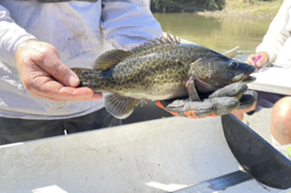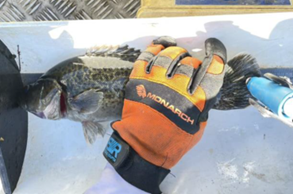Mary River Cod monitoring case study
Disaster Recovery Funding Arrangements Environmental Recovery Program – Biodiversity Conservation, 2021–22 severe events program
In 2019, the Somerset and Wivenhoe Fish Stocking Association (SWFSA) initiated a restocking project to return cod to the Brisbane River catchment using Mary River cod (Maccullochella mariensis) to replace the extinct Brisbane River cod.
Flood events across South East Queensland in 2021–2022 significantly affected water quality and cod habitat at most of the restocking sites. Loss of riparian vegetation, physical displacement of individuals and smothering of habitat by sediment likely resulted in the loss of a significant number of released cod.
SWFSA were successful in applying for a $85,000 grant to restock 21,000 Mary River cod fingerlings and juveniles at select locations along the Brisbane and Bremmer Rivers.
SWFSA were also awarded a $50,000 grant to carry out a catchment-wide survey throughout the Bremmer and Brisbane River catchments to determine the status of the cod restocked to date.
These projects were supported by the jointly funded Commonwealth-State Disaster Recovery Funding Arrangements - Environmental Recovery Program (administered by Department of the Environment, Tourism, Science and Innovation).

Targeted aquatic surveys across 26 sample sites provided baseline data and information on where cod have managed to persist through the flood events, where losses may have occurred and key features of resilient habitats and reaches. This information will also be used to inform future stocking strategies.
All fish and crayfish were counted and recorded before release, and any cod or small lungfish (<700 mm) were placed in a holding tank before being measured, weighed, genetically sampled and tagged (passive integrated transponders (PIT) inserted into the body cavity).

Water quality parameters such as pH, water temperature, dissolved oxygen and conductivity were measured at the water surface at each site, along with basic physical characteristics described in terms of average width and maximum depth.
In general, sites sampled at Warrill Creek, Bremer River, Emu Creek and Stanley River showed good cod habitat conditions with largely intact or reasonable amounts of riparian vegetation, large woody debris, good water depths and little evidence of sedimentation. Conversely, the Brisbane River sites showed the highest degree of flood impact on riparian zones, with only some areas retaining good amounts of large woody debris and rocky areas.

A total of 7,075 fish and five crustaceans were sampled, comprising 31 fish species and one crustacean species.
Mary River cod were caught and/or confirmed at nine of 26 sites. Mary River cod were detected in the upper and mid Brisbane River, Stanley River and Emu Creek systems. The size of cod captured during surveys demonstrated that fish released as 30mm juveniles were able to seek refuge and persist through the extreme flooding event of 2022.
No cod were collected or observed in the Bremer catchment during the survey despite stocking over the past three years. It is possible that fish were simply not where sampling occurred or fish were too deep in the water column to be sampled. Additional monitoring surveys, strengthening of the current angler fish monitoring application and investigating the feasibility of implementing citizen science monitoring programs could improve monitoring outcomes.
Few juvenile cod have been recorded despite the presence of mature fish and suitable breeding habitat. It is possible that the recent floods have displaced these smaller fish and that the floods have affected suitable habitat. Evidence and observations suggest that the Stanley River, upper and mid Brisbane River and Bremer River catchments support suitable habitat and water quality for the species to be sustainable, therefore further research, stocking and habitat conservation and restoration efforts will be essential to ensure the establishment of a self-sustaining cod population. In addition, supplementing stocking with larger fish (>150 mm) may yield greater results as larger fish can withstand competition from other species for food and habitat and may be less vulnerable to direct predation.
Continued support from landholders who manage waterways on private land is also essential to achieving conservation outcomes.


